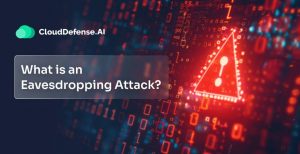What is an Eavesdropping Attack?
An eavesdropping attack, also known as a snooping attack, occurs when a cybercriminal sneakily monitors and intercepts communication in a network between two computers, smart or other device. Through eavesdropping attacks, cybercriminals can modify, steal, or delete sensitive data that is transmitted over a network between two devices.
The attacker usually exploits unsecured network communication to launch such an attack. Through this attack, cybercriminals mainly target sensitive customer information, business information, or any specific information that can be sold to the highest bridges.
Information theft, nation-state surveillance, espionage, or personal surveillance also serve as a primary motive for this attack. It usually occurs when an employee negligently connects to a public network or network without encryption and sends sensitive data to a colleague.
This gives the attacker the opportunity to intercept the transmission through various methods. It is difficult to identify this type of attack thus the best way it can be prevented is by avoiding public Wi-Fi, using VPN, or implementing personal firewalls.
Understanding an Eavesdropping Attack
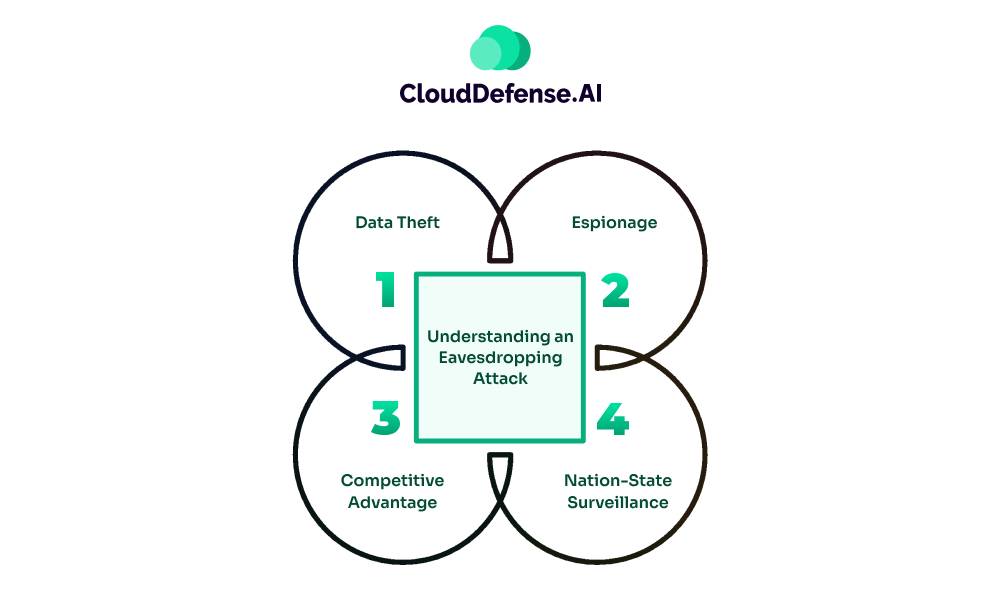
An eavesdropping attack is a process where an attacker steals or intercepts information that is transmitted between two devices over an unsecured network. Unlike other malicious attacks, eavesdropping is quite tricky to detect as the data transmission operates normally.
Usually, an attacker takes advantage of an unsecured network or weakened connection between client and server to launch an eavesdropping attack. In this social engineering attack, attackers look for weakened connections or public Wi-Fi so that when a user sends any sensitive data they can easily reroute the network traffic.
When the cybercriminal successfully exploits a network, they put up a network monitoring software called a sniffer on the server or device to continuously intercept the transmitted data.
Any device placed between the sender and receiver in that network server is a vulnerable point. There are various reasons attackers perform eavesdropping attacks and some of them are:
Data Theft
Data theft primarily serves as the main reason behind the attack and an attacker usually steals business information, card details, account passes, and intellectual property.
Espionage
An attacker often eavesdrops on a company’s network to collect classified data, trade secrets, or intelligence data to gain insight into the activities and strategies of the organization.
Competitive Advantage
Rival organizations often carry out eavesdropping attacks on a specific business to intercept and steal data related to the organization’s strategies, proprietary knowledge, dealings, and plans.
Nation-State Surveillance
On many occasions, state-funded cyberattackers carry out eavesdropping attacks on foreign governments, specific organizations, or users when they suspect any national security issue. Besides, nation-state surveillance is also conducted to get a geopolitical advantage over a foreign government.
Eavesdropping Methods
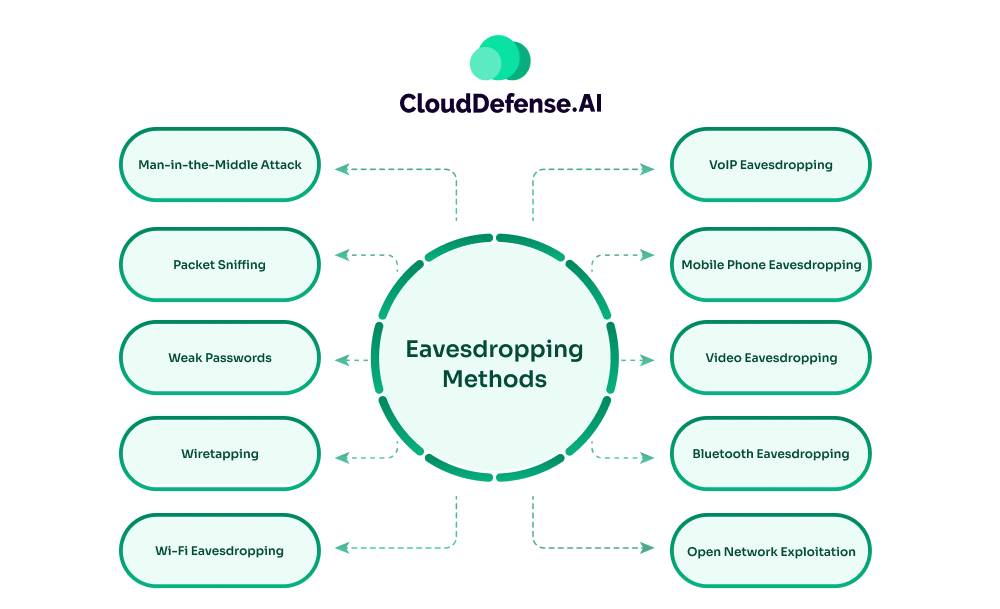
When attackers launch an eavesdropping attack, they utilize various methodologies to intercept the transmission in the network. Most cyberattackers utilize different malicious techniques for eavesdropping while some exploit vulnerabilities.
Here are some popular eavesdropping methods:
Man-in-the-Middle Attack
It is a popular eavesdropping method where cybercriminals put themselves in the middle of communication between two devices or users. Thus, they are able to intercept the message without raising any suspicion.
Packet Sniffing
In this method, the cybercriminal intercepts and analyzes the data packets moving across the network and extracts only the required information. Usually, attackers steal card details, usernames, passwords, and other sensitive details.
Weak Passwords
Exploiting weak passwords is often utilized by attackers to gain access to a network and intercept communication channels to steal sensitive business data. The hackers can easily intercept the communication between two devices and extract data.
Wiretapping
Wiretapping is a physical method where the malicious attacker physically accesses the network infrastructure of an organization and sneakily monitors all the data communication. It is often carried at the data center or by accessing the communication line.
Wi-Fi Eavesdropping
This eavesdropping method serves as a common choice for attackers where they intercept data packets and analyze them to extract valuable information. The attacker within a particular range intercepts a Wi-Fi signal and gathers information like confidential business data, financial data, customer details, or login credentials.
VoIP Eavesdropping
VoIP eavesdropping is a unique methodology where the attacker monitors and intercepts VoIP traffic in a network and steals all the audio data. By intercepting the voice over the internet protocol traffic, the attacker can listen to all the conversations and extract sensitive information from any discussion.
Mobile Phone Eavesdropping
This is a specific eavesdropping technique that is carried out by cybercriminals to intercept voice calls or messages and steal the necessary information or personal data. The cybercriminal carries on the attack by exploiting any vulnerability in the mobile network and through it they gain access to the communication.
Video Eavesdropping
In this technique, the attacker looks for vulnerability in the video communication protocol or the web camera and exploits it to get hold of the video feed. Through this eavesdropping method, the attackers are able to gather visual information and extract business information from the target organization’s confidential meetings.
Bluetooth Eavesdropping
The attacker intercepts the Bluetooth signal of a device and steals all the sensitive data that is being sent from the sender device to the receiver. Attackers often launch this type of attack on IoT devices or laptops that are connected to the primary network of an organization.
Open Network Exploitation
Users often connect to open networks to transmit data to other devices and usually these networks neither have any encryption nor any authentication process. As a result, attackers get the opportunity to monitor the activity of data communication and steal valuable information.
What Does Eavesdropping Mean for Businesses?
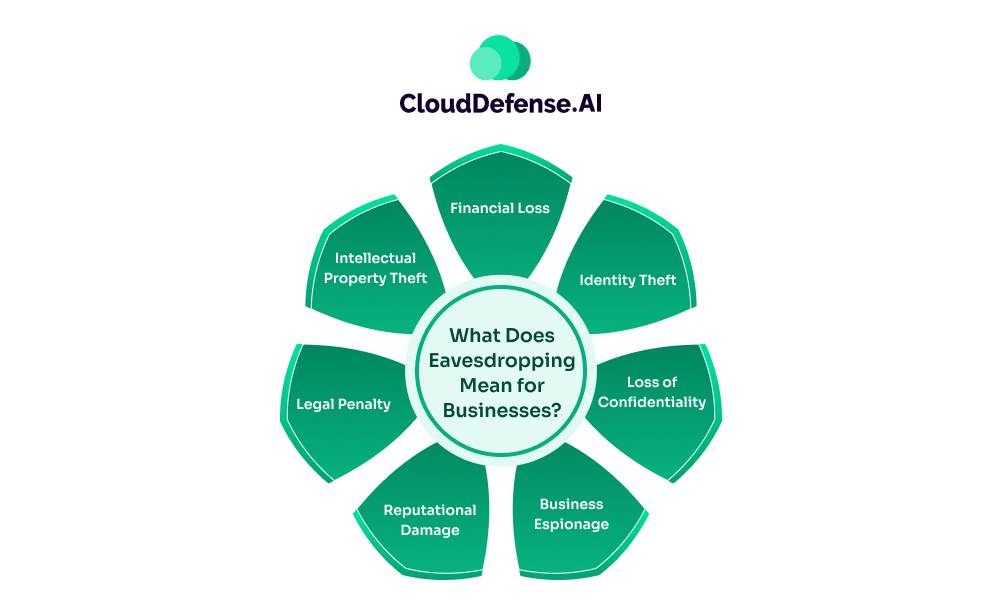
Eavesdropping attacks leave serious implications on businesses as they result in the loss of critical business data, an increase in attack surface, and damage to operations. The organization has to face serious repercussions when an eavesdropping attack occurs.
Here are some impacts that eavesdropping attack has on businesses:
Financial Loss
An eavesdropping attack leads to serious financial loss to a business as attackers access all the sensitive data of the organization.
Attackers mostly steal business secrets, corporate files, and login credentials and sell them to competitors or the open market. In some cases, the attackers ask for ransom in exchange for the sensitive data.
Identity Theft
Through an eavesdropping attack, cybercriminals monitor all the conversations or details that a user communicates through an application. A user might reveal any login credential or sensitive information thinking it is a secured communication and the attacker can use it to carry out an identity theft attack.
Loss of Confidentiality
Eavesdropping attacks also lead to loss of confidentiality as the sensitive communication happening within the organization is completely compromised.
Attackers can intercept sensitive discussions or strategic planning of an organization. This loss of confidentiality can lead to severe consequences in specific organizations like defense, health, and government.
Business Espionage
Eavesdropping attacks on particular businesses often serve as a part of business espionage by competitors or specific cybercriminal groups. It is mostly done by competitor groups to extract business intelligence and trade secrets that can be utilized for competitive advantage or undermine the target organization’s position.
Reputational Damage
Reputational damage and negative publicity are other impacts that an eavesdropping attack has on businesses.
News of data breaches through eavesdropping can lead to losing trust among customers and stakeholders. The reputational damage affects not only future collaborations but also the sales figures and brand image.
Legal Penalty
Eavesdropping attacks also lead to legal and regulatory penalties depending upon the type of data breach and operation of the organization. A data breach in an organization handling sensitive financial data or customer health information can lead to regulatory investigation, hefty fines, or lawsuits.
Intellectual Property Theft
Research institutes or organizations associated with innovation often fall victim to eavesdropping attacks as attackers steal intellectual property. Attackers mostly target advanced research of products, new items or technologies, or hidden strategies that will enable competing organizations to gain a competitive advantage.
How to Prevent Eavesdropping Attacks?
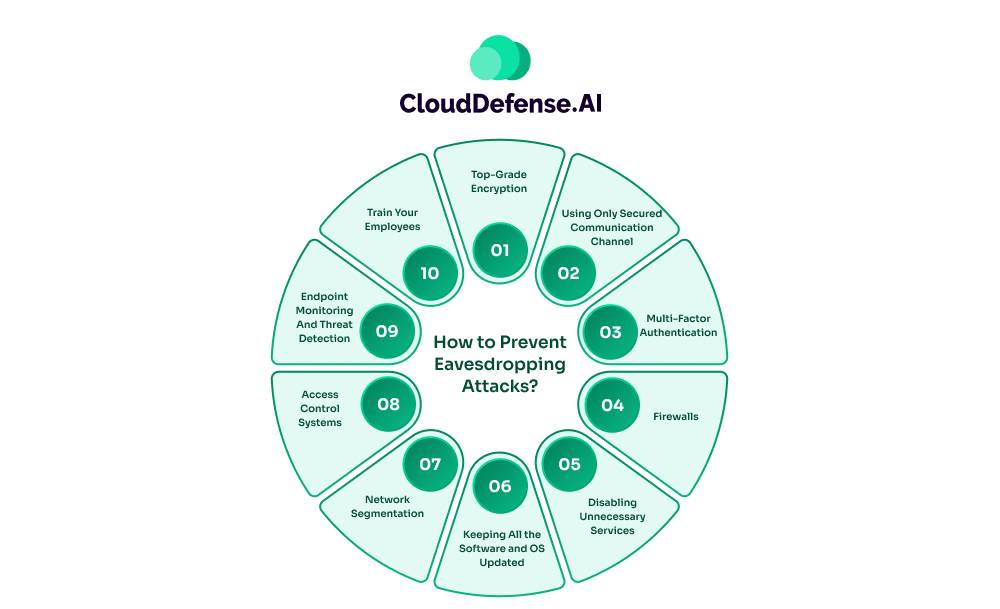
When it comes to preventing eavesdropping attacks, there are several techniques that your organization can employ. However, implementing techniques won’t be sufficient as organizations need to implement them in conjunction with proper user awareness and secure practices.
Here are some ways organizations can prevent eavesdropping attacks:
Top-Grade Encryption
To prevent eavesdropping attacks, organizations need to implement top-grade encryption protocols that will protect all the sensitive communication in the network.
Encryption ensures all the data in the communication channel remains encrypted and unreadable even if the traffic is intercepted. End-to-end and SSL/TLS encryption should be utilized for data transmission in web communications and applications.
Using Only Secured Communication Channel
Only secured communication channels should be utilized whenever data communication occurs.
Use VPN on all the devices when using it for official purposes and it will prevent the data from interception. Making use of encrypted email services for official emails and Wi-Fi networks for various activities will help protect all sensitive data during communication.
Multi-Factor Authentication
One of the best ways to restrict eavesdropping attacks is by enforcing multi-factor authentication or MFA.
It ensures that only authorized and authenticated users can access the data. Even if the login credentials are compromised, it won’t allow unauthorized users to access the sensitive data.
Firewalls
Implementing firewalls is another effective way of minimizing the chances of eavesdropping on data communication in a network. Your organization should place a strong network firewall and personal firewall at endpoints to help monitor all the data traffic.
The security team can also utilize next-gen firewall which also brings on board other cybersecurity measures that also help in identifying potential eavesdropping attacks.
Disabling Unnecessary Services
To minimize the chance of an eavesdropping attack, it would be a good practice to disable all unnecessary services along with protocols and ports on the network. Keeping only necessary services active will prevent attackers from exploiting any loopholes.
Keeping All the Software and OS Updated
Always make sure that the operating system and all the software are kept updated with the latest security patches.
Make sure the device you are using is updated with the latest updates. Updating will eliminate the ability of attackers to exploit the vulnerabilities in outdated OS or software and monitor all the data communication.
Network Segmentation
Another effective way to minimize eavesdropping attacks is by introducing network segmentation that mainly focuses on limiting access to network resources.
Network segmentation makes sure resources in the network are only available to users who need them. Segmenting the network, not only prevents the chance of malicious activity but also enhances network security.
Access Control Systems
You can also utilize access control to limit the access of users to sensitive information on applications and communication channels. Implementing strict access control will make sure only authorized personnel can access business data.
However, you need to implement a well-designed access control that will prevent attackers from finding any way to eavesdrop on communication channels.
Endpoint Monitoring And Threat Detection
Endpoints often serve as the weakest link in an organization’s network and attackers often exploit it to launch eavesdropping attacks. Your organization can utilize endpoint monitoring and threat detection tools that can endpoint and provide alerts when it detects any malicious activity.
Train Your Employees
You also need to educate and aware your employees regarding eavesdropping attacks. Not only will you have to make them aware of the risk of eavesdropping but also educate them on how to identify it. Every employee should be encouraged to follow best practices to secure network communication.
Final Words
In the modern data-driven world, it has become a necessity for every organization to protect their sensitive data in every way. Cyber criminals are evolving with their eavesdropping attacks and they are coming up with new ways to intercept data communication.
By staying informed about eavesdropping attacks, organizations can reduce the chance of falling victim to the attack by a large margin. Thus, this article will guide you through every aspect of an eavesdropping attack and what necessary steps you can take to protect your sensitive data from getting eavesdropped.


